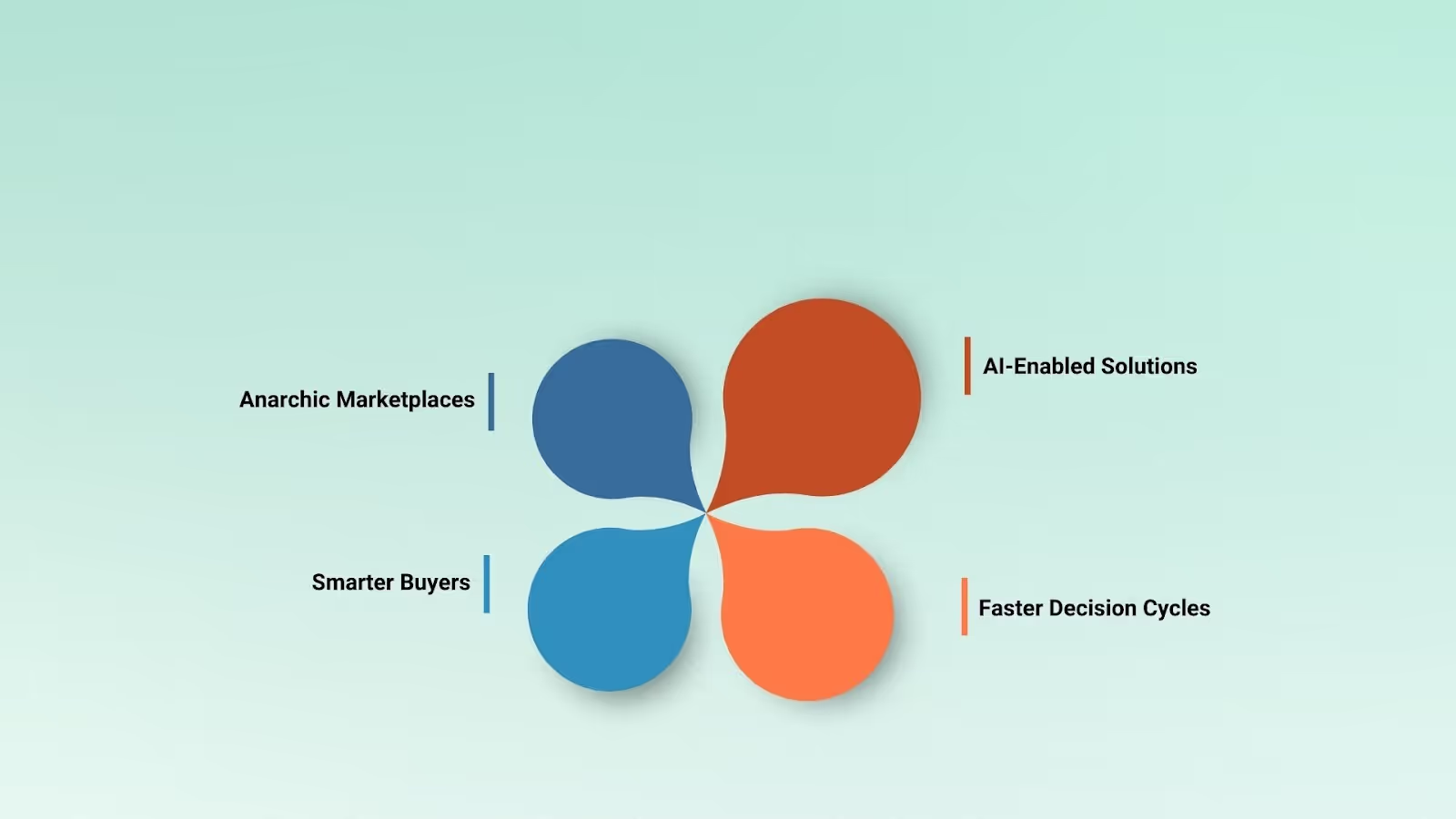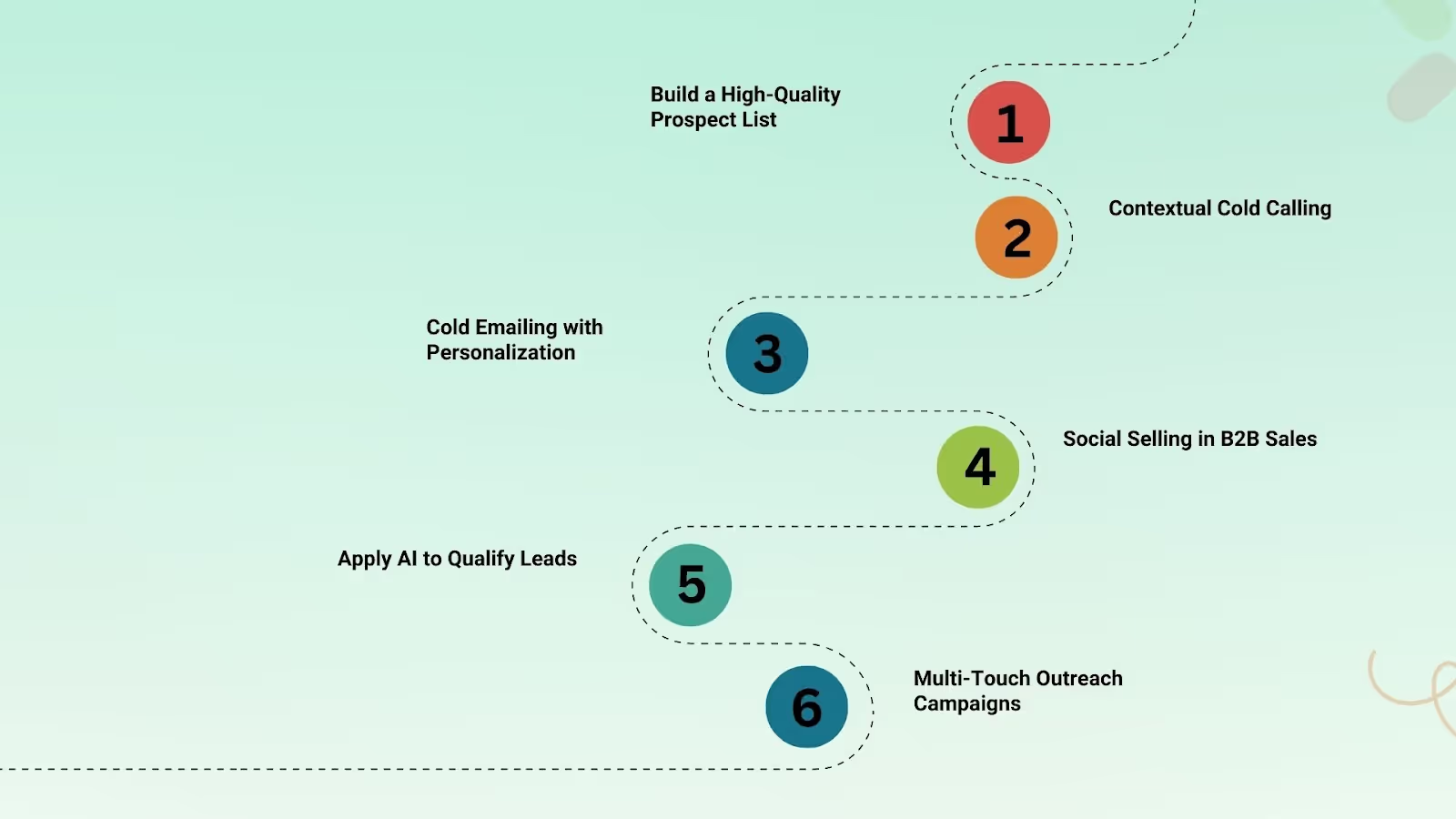Success in today's competitive B2B economy starts with one very critical step: sales prospecting. Without a viable pipeline of good leads, even top-performing sales teams can't meet quota. But in 2025, the issue isn't identifying leads as much as identifying the right leads, those of real need, budget, and buying intent, and connecting with them with messages that break through an increasingly digital-first world.
This blog delves into successful sales prospecting methods, gives insights into how AI is transforming B2B lead generation, and reveals what sales teams are currently doing to keep on converting prospects into high-value customers.
What is Sales Prospecting?
In other words, sales prospecting is the activity of discovering, investigating, and approaching leads that are most likely to benefit from your solution. Unlike blind outreach, true prospecting is strategic, data-driven, and focused, saving waste for sales teams in pursuing unqualified prospects.
Put simply, sales prospecting is not about quantity; it's about quality. The goal is not to talk to everybody but to talk to the right people, at the right time, with the right message. In 2025, this precision-driven approach is essential in order to build a sustainable and scalable sales pipeline.
Why Sales Prospecting is Necessary in 2025

- Anarchic Marketplaces: Customers are receiving cold calls, emails, and LinkedIn messages on a daily basis. Breaking through the clutter, salespeople must utilize sharper, more focused tactics that break the status quo.
- Smarter Buyers: B2B buyers today research intensively prior to engaging with a vendor. In fact, 50% of leads are not appropriate for what the majority of companies do, so they need pinpoint targeting. They have determined their problem, possible solutions, and competitive choices by the time they chat with sales. That means prospecting as insight-driven dialogues rather than blanket pitches.
- AI-Enabled Solutions: Solutions like Pepsales AI have transformed prospecting by automating mundane processes like list building, lead scoring, and email customization. This allows sales reps to spend less time looking and more time selling.
- Faster Decision Cycles: As markets are constantly evolving, organizations that prospect early and build leads close deals before competition even gets a chance. Velocity is the competitive advantage of today.
Key Sales Prospecting Strategies

1. Build a High-Quality Prospect List
Any prospecting strategy's secret is a quality, high-quality list of prospects. Calling the wrong people is shouting into space, time-consuming, effort-stealing, and opportunity-wasting.
Building a better list in 2025:
- Smarter filtering: Use LinkedIn Sales Navigator, Crunchbase, or AI-powered databases to filter prospects by industry, company size, job title, and geolocation.
- Buy signals: Watch for new funding announcements, new product launches, or hiring trends as buy signals of probable demand.
- Effective dynamic updates: Lists must be dynamic. AI solutions like Pepsales AI can dynamically update databases in real-time, so that prospect information is never outdated.
Example: Rather than cold calling 10,000 generic contacts, a salesperson selling to cybersecurity SaaS companies can build a highly targeted list of 500 mid-sized companies that have newly brought on a Head of IT Security, a very good intent signal.
2. Contextual Cold Calling
Cold calling is far from dead. When done right, it's one of the fastest ways to initiate a substantive sales conversation. Yet, still, only 2% of cold calls result in a meeting, so context and personalization matter these days
Best practices:
- Get ready ahead of time: Review LinkedIn profiles, press releases from the company, or industry news to craft a relevant opener.
- Lead with value, not product: Open questions that ask for pain points instead of the hard sell.
- AI coaching: New sales tech provides real-time tone, pace, and objection-handling feedback on calls, making reps smarter.
Example: Instead of starting with "I'd like to discuss our CRM with you," a rep can say
Hi Sarah, I noticed your company expanded into three new areas this year. Most growing businesses have a hard time managing remote sales teams. Are you also experiencing that?"
3. Cold Emailing with Personalization
Inboxes are saturated, but cold emailing is still worth it when done with precision. In fact, personalized emails increase response rates by 32%, but 70% of salespeople still use canned templates. Personalization and brevity are the key.
How to craft effective cold emails in 2025:
- Personalized subject lines: Mention the company or specific pain point to increase open rates.
- Make it concise: 3–4 sentences maximum. Long emails are abandoned.
- Value-driven message: Problem-solving, not selling features.
- Social proof: Customer testimonials or case studies lend credibility at once.
- Testing and optimization: Use A/B testing to test subject lines, tone, and CTAs.
Example:
Subject: "Scaling onboarding at [Prospect Company]"
Body
Hi John, I saw [Prospect Company] expanding the engineering team. Many of our clients had issues with getting new hires up to speed. We helped [Similar Client] reduce onboarding by 35%. Do you know how we did that?"
4. Social Selling in B2B Sales
Social selling is not an option in 2025; it's obligatory. Even as buyers are becoming more active on LinkedIn, X (Twitter), and specialty-interest sites, salespeople can't afford to be nowhere to be found on these channels.
Successful strategies:
- Content posting: Content posting for thought leadership, video, or case studies attracts prospects organically.
- Join the conversation first, pitch second: Reply to a prospect's post prior to offering a connection.
- Multimedia outreach: Leverage LinkedIn voice recordings or brief videos to get through to the noise.
- Community building: Connect with industry groups or forums before selling.
Example: A rep can like and comment on a prospect's LinkedIn post on "supply chain woes," then start a DM with a case study on how companies like theirs optimized efficiency.
5. Apply AI to Qualify Leads
Wasting time on non-qualified leads. Enter qualification with AI.
Benefits of AI-driven qualification:
- Predictive scoring: Solutions like Pepsales AI qualify leads based on buying intent, as measured by activities such as website visits, email opens, or inquiries about your products.
- Contextual insights: AI can detect high triggers (e.g., a funding event, a new CMO appointment), raising the likelihood of a lead making a purchase.
- Smarter prioritization: Reps can focus on the 20% of leads that will generate 80% of revenue.
Example: Rather than cold-call 100 random leads, AI can select 12 most likely to buy in 60 days, radically streamlining efficiency.
6. Multi-Touch Outreach Campaigns
In 2025, one touch will not be enough. According to research, 8–10 touches are needed to schedule a meeting. A multi-touch campaign establishes trust and familiarity.
How to create campaigns:
- Cold email → LinkedIn connection → Follow-up call → Share a case study → Invite to a webinar.
- Each touchpoint must offer differentiated value and not be the same message.
- Employ CRM and AI software to track engagement and invite follow-up at the right moment.
Example: The prospect does not reply to your first email. You connect with them on LinkedIn and post a comment on their update. A week later, you send a case study that is appropriate. On the 4th touch, the prospect is warm enough to meet in person.
Probing questions to ask in conversations
- Volume over quality: More does not always mean better. A minimal, qualified list is better than a huge, unfiltered one.
- Generic messaging: Prospects turn off generic pitches.
- Lost follow-ups: 80% of the sales are made in 5+ touches, yet most reps give up after 1–2 attempts. Consistency is key. Research indicates 44% of reps lose after a single follow-up, leaving money on the table
- Forgotten existing customers: Upselling and cross-selling are frequently forgotten profit sources.
Comparison: Traditional Prospecting vs. AI-Powered Prospecting
Prospecting has been revolutionized in the sales team's approach. Below is how prospecting was previously done compared to AI-powered prospecting in 2025:
- List Building
Traditional: Manually performed, time-consuming, and stale.
AI-Powered: Automated, dynamic, and continuously updated for accuracy.
- No of leads
Traditional: Qualified on gut feel and limited research.
AI-Powered: Predictive scoring and data-driven insights uncover the best opportunities.
- Outreach
Traditional: Template-based cold calling and templated email blasts.
AI-Powered: Hyper-personalized, multi-channel outreach that resonates with prospects.
- Efficiency
Traditional: Low return on investment per effort.
AI-Powered: Improved prioritization, lower cost, and improved conversion rates.
- Rep Productivity
Traditional: Reps spend inordinate amounts of time searching for leads.
AI-Powered: Reps spend their time engaging with prospects and closing deals while AI handles admin tasks.
It's evident that the future of prospecting will be AI-driven, where sales reps can do less paperwork and more engaging conversation-building.
Conclusion: Sales Prospecting as the Engine of Growth
Prospecting is no longer blasting mass communications and hoping someone bites back; now, it is precision, personalization, and persistence. By connecting old-school methods like cold calling and cold emailing with new-school methods like social selling, multi-touch marketing, and AI qualification, businesses can stock up their sales pipeline with high-quality prospects consistently.
The winners of B2B selling in 2025 will prospect smarter, not harder.
Ready to take your sales prospecting to the next level?
With Pepsales AI, you can close deals faster and fill the pipeline faster with smart automation
Schedule a free demo today and learn how Pepsales AI can enable you to build more qualified leads, close deals faster, and take over your market.









.avif)
.avif)
